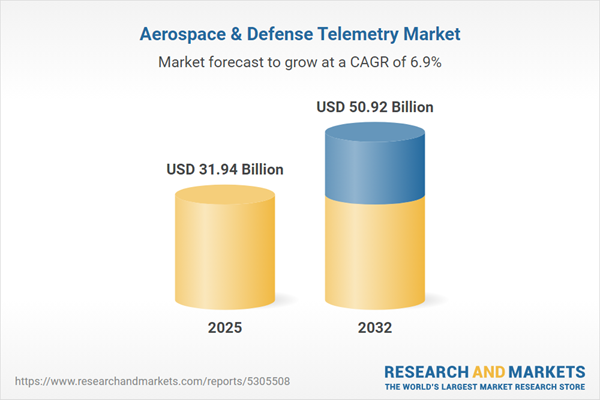Speak directly to the analyst to clarify any post sales queries you may have.
The aerospace and defense telemetry market is evolving as organizations demand heightened security, seamless operational intelligence, and robust communication networks across increasingly sophisticated mission environments. Senior decision-makers are prioritizing adaptive telemetry solutions designed to keep critical operations resilient and informed.
Market Snapshot: Aerospace & Defense Telemetry Market
The aerospace and defense telemetry market is on a steady growth path, projected to increase from USD 29.92 billion in 2024 to USD 31.94 billion in 2025, ultimately reaching USD 50.92 billion by 2032. This growth represents a CAGR of 6.87%. The market is expanding due to continuous investments in telemetry infrastructure, stronger data management, and a growing focus on securing operational data in real time. By implementing advanced communication and analytics frameworks, the sector is supporting modernization and efficiency in mission-centric environments and is poised to meet the ever-changing requirements of global operations.
Aerospace & Defense Telemetry Market: Scope & Segmentation
This report provides a detailed strategic assessment for senior executives and procurement leads, enabling sound decisions across major market segments and technology domains:
- Platforms: Ground vehicles, manned aircraft, naval vessels, submarines, satellites, and unmanned aerial systems utilize purpose-built telemetry solutions to meet unique operational and security demands for both commercial and defense applications.
- Components: Antennas, RF modules, data acquisition units, and sensors are essential for delivering accurate real-time telemetry and analytics, ensuring ongoing system performance monitoring.
- Applications: In-flight analytics, asset testing, predictive maintenance, anomaly detection, and performance assessment support comprehensive mission system oversight and promote effective asset lifecycle management.
- End-Users: Commercial airlines, military forces, aviation service providers, space agencies, and operators of unmanned systems are integrating advanced telemetry as part of evolving mission profiles and technological upgrades.
- Frequency Bands: Adoption of C, Ka, Ku, L, S, and X bands delivers secure, resilient communication for complex, mission-critical environments with necessary system redundancy.
- Regions: Distinct deployment strategies emerge across the Americas, Europe (particularly the UK, Germany, France), Middle East & Africa, and Asia-Pacific, with heightened technology adoption and regulatory cooperation noted in China, India, and Japan.
- Companies: The competitive environment includes Lockheed Martin, Northrop Grumman, Raytheon Technologies, Boeing, L3Harris Technologies, BAE Systems, Thales, Leonardo S.p.A., Honeywell, and General Dynamics, each advancing industry technology and building strategic partnerships.
Aerospace & Defense Telemetry Market: Key Takeaways
- Real-time telemetry is driving improved situational awareness and informed cooperation, supporting decision-makers in rapidly changing and high-stakes operational landscapes.
- Sophisticated analytics integrated with wireless telemetry streamline asset management, enabling adaptable responses to varied mission scenarios.
- Adoption of modular sensor arrays and advanced hardware facilitates efficient upgrades, improves system preparedness, and maximizes asset operational cycles.
- Shifting to open and interoperable telemetry architectures supports communication between diverse platforms, enhancing flexibility and mission response capability.
- Procurement leaders are emphasizing regulatory compliance, risk management, and increased supply chain efficiency to ensure reliability and security across communication systems.
- Collaboration across industry stakeholders and a focus on technical workforce development help overcome evolving technical barriers and uphold critical mission dependability.
Tariff Impact on Supply Chains and Sourcing
Recent U.S. tariff adjustments have raised component costs for aerospace and defense telemetry suppliers. Organizations are countering these challenges by diversifying sourcing, strengthening local partnerships, and expanding regional manufacturing operations. These initiatives boost supply chain resilience, aid in meeting global compliance standards, and reinforce operational stability through deeper control of vertical integration.
Methodology & Data Sources
The research integrates executive and technical interviews, patent literature reviews, regulatory assessments, and proprietary market intelligence. This comprehensive approach ensures insights are both credible and practical, empowering stakeholders to address emerging trends and operational risks in the aerospace and defense telemetry sector.
Why This Report Matters
- Offers actionable market segmentation and data-driven insights, supporting executives and procurement teams in making confident investment decisions within the aerospace and defense telemetry market.
- Delivers analysis on regulatory and geopolitical factors, guiding risk mitigation and optimization of logistics and sourcing across global supply chains.
- Enables leadership to benchmark suppliers and adapt strategies to maintain agility, supporting ongoing operational resilience and long-term competitiveness.
Conclusion
Innovation in telemetry analytics, cybersecurity, and supply chain management is shaping the aerospace and defense telemetry industry. Continued collaboration, workforce upskilling, and disciplined modernization remain crucial for organizations seeking to sustain performance and strategic leadership as the market progresses.
Additional Product Information:
- Purchase of this report includes 1 year online access with quarterly updates.
- This report can be updated on request. Please contact our Customer Experience team using the Ask a Question widget on our website.
Table of Contents
3. Executive Summary
4. Market Overview
7. Cumulative Impact of Artificial Intelligence 2025
Companies Mentioned
The companies profiled in this Aerospace & Defense Telemetry market report include:- Lockheed Martin Corporation
- Northrop Grumman Corporation
- Raytheon Technologies Corporation
- The Boeing Company
- L3Harris Technologies, Inc.
- BAE Systems plc
- Thales S.A.
- Leonardo S.p.A.
- Honeywell International Inc.
- General Dynamics Corporation
Table Information
| Report Attribute | Details |
|---|---|
| No. of Pages | 185 |
| Published | October 2025 |
| Forecast Period | 2025 - 2032 |
| Estimated Market Value ( USD | $ 31.94 Billion |
| Forecasted Market Value ( USD | $ 50.92 Billion |
| Compound Annual Growth Rate | 6.8% |
| Regions Covered | Global |
| No. of Companies Mentioned | 11 |









